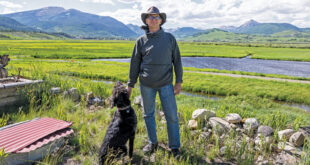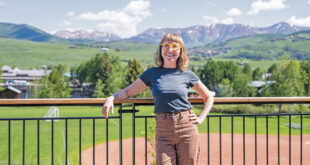From Queens, N.Y. to Crested Butte, the daily grind for Eileen Hughes would seem a torrent of high adventure for the average, work-a-day bloke. This long-time local recently landed in the midst of a new challenge, the long-vacant position of general manager for KBUT Community Radio.
Hughes went to high school in Queens and earned her bachelor’s degree at the State University of New York (SUNY) at Binghamton. “I studied anthropology,” she laughs. After graduation, she headed west. And north.
“It was during the hippy, back-to-the-earth movement. I thought all I needed was land,” she recalls.
A friend lived in Alaska, a place with the space. Hughes spent a month in Anchorage before heading to Homer, a small fishing village at the tip of the Kenai Peninsula. “That’s where I met Jack.”
The couple spent eight years commercial fishing for salmon and halibut, and even shrimp for a couple of winters. Jack still returns to Alaska each summer to fish. Local Crested Buttians and Alaskans know him as Captain Jack.
“I really liked fishing, but after a few years, husband and wife, well, let’s just say there can only be one skipper at a time. Jack likes to say it was like, ‘It’s time to either get your own boat, or…’ I don’t have the guts to be in charge of my own boat, and I got seasick.
“There was no radio in Homer then, period. I lived a mile off the road, no electricity, no running water. We melted snow for water in winter,” she continues. A fellow fisherman, Kevin Hogan, started the process to get a radio station started. “I helped him do a community needs survey,” says Eileen. That was her first exposure to public broadcasting.
KBBI Homer was built in the early 1980s. “I just started volunteering. Actually, I did classical music. Literally, I walked in one day and there was nobody to do the show, so they asked, ‘Can you help?’”
Sometime later, Eileen and Jack were piloting a boat north from Seattle, where she’d ducked into a bookstore and bought a treatise on broadcast media. “I decided I wanted to be a news reporter,” she says.
“KBBI was a well-funded operation,” says Hughes. There was a two-person daily news team, a call-in talk show and Alaska News Nightly. “One reporter I worked with became a producer for Prairie Home Companion.” Corey Flintoff and Peter Kenyon were once KBBI reporters too, both now foreign correspondents for National Public Radio. “Alaska at that time was known as a great training ground for that caliber of talent,” notes Eileen.
Yes, KBBI was well funded, and right in town, but Homer was still remote, Alaska the last frontier. “We had no plumbing. We had an outhouse,” says Hughes. “The radio is very much listened to in Alaska. A lot of people live in isolation. The radio is their friend.”
As late as the early 1980s, many people living on the Kenai Peninsula still didn’t have a telephone. Radio filled the communications gap between friends and family with announcements called the Bay Bush Lines. “You might here something like, ‘Hi Mom and Dad. We’re across the bay. Seas are too rough now. We’ll be home in two or three days.’ I believe they still do them,” Eileen says, “but there aren’t that many.”
Hughes worked as KBBI’s news director for nearly nine years. “I hate to say this, but when I started doing news here, I found it quite boring.” Natural resources in Alaska are a dominant topic, as are commercial fishing, hunting, tourism, oil—and the community and human-interest stories, always colorful.
“Politics in Alaska are interesting too,” Eileen says. “It’s a big state, but they’re so up-close.” Once, Hughes was hosting a political debate between two state senate candidates. “One guy accused the other of taking a brown bag of cash from an oil company,” she says. The accusation was far from spontaneous, a planned publicity stunt on the side of the accusing candidate. “The one guy accuses the other guy, then they open the doors to the studio and in bursts a bunch of Anchorage reporters, snapping pictures.”
She also recalls a tale of two 19-year-old crab fishermen. “They had a big boat,” says Hughes. “The original story was that the craft had drifted into Soviet waters.” This was before Glasnost. “It was a big, international incident that made the national news. The boys were detained for a month by the Soviets. I interviewed them on my show, after their release. Turns out they were going to Big Diamede [Island] to buy t-shirts!”
After some time in Homer, Eileen and Jack conjured a new plan, what was supposed to be a temporary detour from their current course. “We’d done some backcountry skiing in Alaska, but to ski there, we had to take a boat across the bay. We wanted to learn to ski better, so we were going to spend a winter at a resort somewhere. We asked three friends independently, ‘Where should we go?’ They all said Crested Butte. We said, ‘Where’s that?’ We had no idea, but that’s where we went. We didn’t get good enough in one year. We’re still working on it.”
Hughes became involved with KBUT in the same way she had with KBBI, as a volunteer. “Bonnie Chlipala was the manager then. She asked me to put together a little news staff. I trained a few people and became an independent producer.”
Soon, Hughes became the program director, a position she held for three years before moving on to a job with the town of Crested Butte, first part-time, then full-time as the town clerk, a position she held for 10 years.
Hughes took charge at KBUT mid-December of 2012, where the station had been without a manager for many months. “There are definitely some equipment needs I’m concerned about,” she says. “And I’d like to initiate some internal procedures so that things can run smoothly in a crisis situation. It’s different now than it was. Things have certainly advanced. The website requires tending to. We now have a multi-platform presence.”
Eileen enjoys all that Crested Butte has to offer, including biking, hiking, rafting and every mode of skiing—backcountry, XC touring, skate skiing, and telemarking on the mountain. Radio is still a passion, too, a talent well-forged, making her an ideal choice to nudge KBUT back on-course.
“I think there’s a place for radio here, and always will be,” Eileen says. “There are still plenty of people who rely on KBUT, who think of it as their friend in the same way as those isolated in remote Alaska.” Hughes herself has no TV, a radio loyalist to the core.
You can hear her on-air every Thursday night at 6:30, host of the Dirt Farmer’s Revenge.
The station turned 26 years young this fall. KBUT’s winter pledge drive is set to begin Monday morning, February 11.
Check Also
Profile: Natalie Pfister Riha
By Dawne Belloise Crested Butte native Natalie Pfister Riha has that sort of can-do-anything common …
 The Crested Butte News Serving the Gunnison Valley since 1999
The Crested Butte News Serving the Gunnison Valley since 1999




